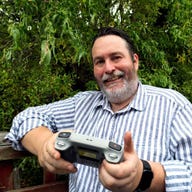
1,0002,0003,0004,0005,0006,0007,0008,0009,00010,000
Sqft of Lab Space
ZDNET's recommendations are based on many hours of testing, research, and comparison shopping. We gather data from the best available sources, including vendor and retailer listings as well as other relevant and independent reviews sites. And we pore over customer reviews to find out what matters to real people who already own and use the products and services we’re assessing.
When you click through from our site to a retailer and buy a product or service, we may earn affiliate commissions. This helps support our work, but does not affect what we cover or how, and it does not affect the price you pay. Neither ZDNET nor the author are compensated for these independent reviews. Indeed, we follow strict guidelines that ensure our editorial content is never influenced by advertisers.
ZDNET's editorial team writes on behalf of you, our reader. Our goal is to deliver the most accurate information and the most knowledgeable advice possible in order to help you make smarter buying decisions on tech gear and a wide array of products and services. Our editors thoroughly review and fact-check every article to ensure that our content meets the highest standards. If we have made an error or published misleading information, we will correct or clarify the article. If you see inaccuracies in our content, please report the mistake via this form.
ZDNET's reviewers spend weeks to months testing each laptop on this list, using it for both everyday tasks like browsing, streaming, and gaming, to more performance-intensive work like photo and video editing. We aim to give you a view into how each laptop could actually fit into your life and workflow, and the pros and cons of their various features like performance, display, and battery life.
Let's talk USB-C chargers. Not the big, powerful GaN models that can power laptops and charge a multitude of devices simultaneously, but the sort of charger that someone might need for their smartphone or tablet. You know, the sort of thing that once might have been included with a new device, but is often now eliminated to increase profits.
So let's take a look at a selection of the best USB-C chargers on the market for your smaller devices.
Also: The best power banks: Expert tested
What is the best USB-C charger right now?
I've been testing chargers ranging from small USB-Cs up to large portable power stations for years. It's difficult to distill down a shortlist of the best USB-C chargers, but based on my previous testing, research, and user reviews, I've got a roundup of the best. My pick for the best USB-C charger overall is the Anker 313 45W USB-C charger, thanks to its great value and compact size. But if you're in the market for something more powerful, check out the rest of my picks for top USB-C chargers.
The best USB-C chargers of 2025
The Anker 313 is a charger that's about as good as they get. This compact 45W charger can output the full 45W to Samsung devices that support Super Fast Charging 2.0 (you will need a compatible 5A/100W E-Marked SUB-C-to-USB-C cable to pull this off).
What's more, this charger is 30% smaller than other 45W chargers that don't feature fold-away prongs.
This charger has over 5,000 ratings on Amazon and scores an excellent 4.8/5.0, which makes it an easy pick for the best USB-C charger overall.
Anker 45W features: 1x USB-C | 45W max output | Inputs: 110-240V
Read More
Show Expert Take Show less
More power is always better, right? Not so when it comes to chargers. I've included this alongside the Anker 313 because, for most, a 45W is more than enough power. But those who might want to charge a laptop or other power-hungry device will benefit from the extra power offered with the 315 and see the larger size and higher cost as a worthwhile trade-off.
If you need that extra power, this charger has it. It can charge a 13-inch MacBook Pro's battery from zero to 50% in 38 minutes.
The reviews for this USB-C charger on Amazon are again excellent, with the charger scoring 4.8/5.0.
Anker 315 67W features: 1x USB-C | 67W max output | Inputs: 110-240V
Read More
Show Expert Take Show less
Need both USB-C and legacy USB-A? This Ugreen option is a great charger for you, combining the best of both worlds.
If you use just the USB-C port, this charger can support a full 35W draw. If you connect two devices, the USB-A port supports up to 7.5W, while the USB-C port's capability drops to a maximum of 25W.
The charger is nice and compact, featuring fold-away prongs. It's great for traveling or throwing into a bag for charging while away from the home or office.
Ugreen is a premium hardware maker, and the reviews reflect this. Owners highlight how lightweight, durable, and powerful the charger is, and give it a 4.7/5.0.
Ugreen Nexode 35W features: 1x USB-C + 1x USB-A | 35W max output | Inputs: 100-240V
Read More
Show Expert Take Show less
Do you need a bunch of chargers for your home or office? Few people want to spend $30+ on a charger if they need to buy a lot of them, but what about spending $12 on four chargers and still getting a decent-quality unit?
This is what you get with this CXX pack -- four cheap and cheerful chargers that are on par with what you'd expect from a charger shipped with a mid-tier or budget smartphone.
I'm normally wary of cheap chargers, but these have passed all my safety tests, so I'm confident in recommending them. And don't take my word for it -- these scored a strong 4.6/5.0 on Amazon.
CXX 20W features: 1x USB-C + 1x USB-A | 20W max output | Inputs: 100-240V
Read More
Show Expert Take Show less
There's an impression among the general public that Apple gear is expensive, and on the whole, that's not incorrect. But Apple makes what is probably the best-engineered 20W USB-C charger, and you can pick it up for only $15.
Sure, it's only 20W, only has a single port, and the prongs don't fold away, but it's a fantastic charger that will last you years.
And with over 218,000 reviews and a rating of 4.8/5.0, it's clear that it's a winner among users.
Apple 20W features: 1x USB-C | 20W max output | Inputs: 110-240V
Read More
Show Expert Take Show less
The Anker 313 USB-C charger is my pick for the best USB-C charger overall. It's inexpensive, and the 45W output is enough for most people's needs. I like this one so much that I normally have a few with me to gift people who are in need of a charger for their smartphone or tablet.
USB-C Charger | Price | Ports | Max Power | Max Single Port Power Output | Multiple Port Power Output | Amazon Rating |
Anker 313 45W | $20 | 1x USB-C | 45W | 45W | N/A | 4.8/5.0 |
Anker 315 67W | $25 | 1x USB-C | 67W | 67W | N/A | 4.8/5.0 |
Ugreen Nexode 35W | $17 | 1x USA-C & 1x USB-A | 35W | 35W | USB-C: up to 25W | USB-A: up to 7.5W | 4.7/5.0 |
CXX 20W (4-pack) | $12 | 1x USA-C & 1x USB- | 20W | 20W | 15W max | 4.6/5.0 |
Apple 20W | $15 | 1x USB-C | 20W | 20 | N/A | 4.8/5.0 |
Choose this [topic keyword]… | If you want… |
Anker 313 45W | A decent all-round USB-C charger. This has enough power for smartphones and tablets. |
Anker 315 67W | Another great USB-C charger. This one has even more power at its disposal, and will even work for laptops. |
Ugreen Nexode 35W | A charger that's also good for legacy devices. This one has both USB-C and USB-A ports for full flexibility. |
CXX 20W (4-pack) | A bunch of cheap chargers at a decent price. These work out at $3 a unit and are perfect for smartphones and tablets. |
Apple 20W | An Apple-branded charger. This is a great charger, and you can pick it up for only $15. |
There are a number of factors to consider when choosing a USB-C charger:
- Power output: The wattage of the charger determines how quickly it can charge your device. Higher wattage chargers can deliver more power and as such charge devices faster (but only as fast as the device can draw the power). Also, while lower-wattage chargers are perfect for smartphones and tablets, higher wattage chargers (60W and above) are needed for laptops.
- Ports: Consider how many devices you need to charge simultaneously. Some USB-C chargers come with multiple ports, including USB-A ports, which can be useful for charging older devices. Multi-port chargers can be handy and reduce the need for multiple chargers, but can add unnecessary bulk and cost if you don't need them.
- Build quality: Choose chargers from reputable brands, as these are going to adhere to safety standards. Poor-quality chargers can bring risks such as overheating, short-circuiting, and even causing fires. It's a good idea to look for certifications such as UL, ETL, CE, or FCC to ensure the charger meets safety regulations (but be aware that these can be fraudulently printed onto poor-quality chargers).
Every year I test dozens of chargers, both in the test lab and in real-world conditions, and there are certain things I look for in a charger if it is to make it onto my recommended list:
- First, does it do what it says it will do? This isn't as easy as plugging it in to see if it will work, but I also test the charger under heavy and sustained loads (because even a poor-quality charger might be able to work for a few minutes). I also test single port load and multi-port loads to make sure these are in line with the specs. To get a passing grade, a charger needs to output the rated power for several hours.
- Is the charger safe? I carry out several electrical safety tests, and also thermal measurements -- because no one wants an overheating charger in the home.
- Is it robust? Can it handle being plugged and unplugged repeatedly? Are the ports good quality? Can the charger handle being dropped and kicked about, because this is the sort of abuse it's going to get in day-to-day use, especially if it's a travel charger.
In addition to that, I've also carried out extensive research into USB-C chargers, taking into consideration user reviews, competitor analysis, and the like. While I can do a good job on testing the charger in front of me, user reviews and ratings can tell me a lot about the quality of a product over time and also how it performs over longer time scales. (For more on our testing process, check out how we test portable power stations.)
As a rule of thumb, I tend to stick with the following:
- For smartphones and tablets: 18W - 35W
- Laptops: 60W+
When I'm testing devices, I have set 45°C/113°F as the point at which I start to have concerns. This is the temperature at which things stop feeling hot and people start feeling pain, according to the safe "no injury" temperature range chart.
The ASTM C1055 (the Standard Guide for Heated System Surface Conditions that Produce Contact Burn Injuries) states that the average person can touch objects up to 60°C/140°F for up to five seconds without sustaining irreversible burn injuries.
Need a few more options to choose from? Here are a few that didn't make it to the main list, but are still excellent chargers.

 1 week ago
10
1 week ago
10








 English (US) ·
English (US) ·